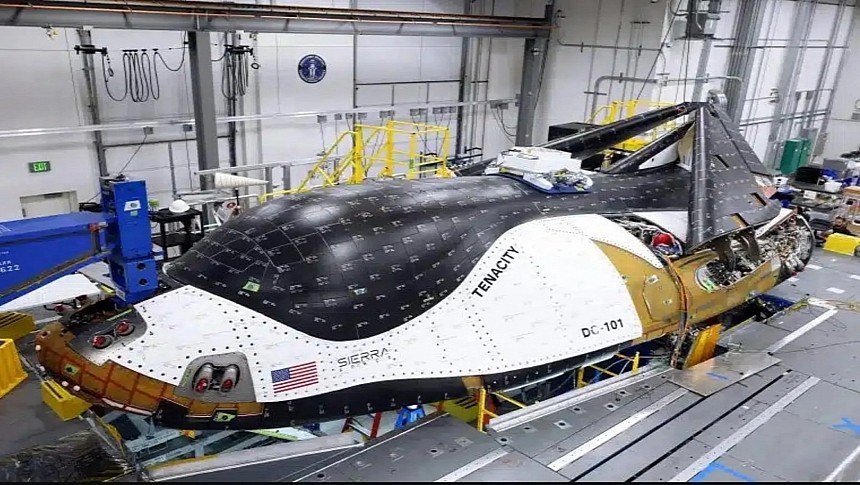After more than a decade of research, development, and engineering challenges galore, Sierra Space has proudly announced the completion of its first Dream Chaser reusable space plane. With the promise of swift, reliable crew and cargo transportation to low-Earth orbit using smaller, more manageable spacecraft than what NASA fielded with the Space Shuttle, Sierra Space hopes this first production Dream Chaser can set the trend for all privately developed space planes going forward. From the looks of the latest press photos, there's reason to be excited.
With dimensions of nine meters (29.5 ft) long, a seven-meter (22.9-ft) wingspan, and a curb weight of 9,000 kg (19,841.6 lbs), Dream Chaser's appeal comes not from its ability to haul massive loads of cargo all at once as Space Shuttle did. But rather through the ability to launch large fleets of smaller spacecraft capable of being manufactured quickly for a wide degree of different missions in Earth's orbit. Before the first space-worthy example, dubbed Tenacity, was completed recently, two atmospheric test examples provided valuable insight into the distinct flight characteristics of such a peculiar lifting-body spacecraft.
These atmospheric flights were facilitated via Sikorsky Skycrane and Boeing-Vertol Chinook support helicopters, which hoisted the twin Dream Chaser un-crewed test articles to a pre-determined altitude before dropping them to test their handling traits. If all goes to plan, Dream Chaser Tenacity will be fastened aboard the novel Vulcan Centaur two-stage, heavy-lift rocket due to have its own first test flight in December 2023 before a series of NASA contracted commercial-resupply (CRS) missions are undertaken, potentially to run cargo resupply missions the International Space Station at some point shortly.
For Sierra Space, itself a wholly separate corporate offshoot of the Sierra Nevada Corporation, Dream Chaser Tenacity's completion marks the beginning of the next generation of human-crewed space planes. The space plane form factor has remained largely dormant since the retirement of the Space Shuttle fleet after the end of the STS-135 mission aboard the Atlantis Shuttle back in July 2011. Since then, only un-crewed military space planes like the Boeing X-37 have made the trip to low-Earth orbit.
Should all go according to schedule, Dream Chaser Tenacity is due to launch its first orbital test flight to the ISS without cargo out of Space Launch Complex 41 at the Cape Canaveral Space Force Base in Florida sometime in April 2024 and land at the old Shuttle Landing Facility nearby at mission's end. Once the ISS is retired and de-orbited sometime in the 2030s, Dream Chaser will spend its career servicing the next generation of private and government space stations due to launch into LEO over the next decade. Safe to say, Sierra Space will not be strapped for contracts any time soon.
These atmospheric flights were facilitated via Sikorsky Skycrane and Boeing-Vertol Chinook support helicopters, which hoisted the twin Dream Chaser un-crewed test articles to a pre-determined altitude before dropping them to test their handling traits. If all goes to plan, Dream Chaser Tenacity will be fastened aboard the novel Vulcan Centaur two-stage, heavy-lift rocket due to have its own first test flight in December 2023 before a series of NASA contracted commercial-resupply (CRS) missions are undertaken, potentially to run cargo resupply missions the International Space Station at some point shortly.
For Sierra Space, itself a wholly separate corporate offshoot of the Sierra Nevada Corporation, Dream Chaser Tenacity's completion marks the beginning of the next generation of human-crewed space planes. The space plane form factor has remained largely dormant since the retirement of the Space Shuttle fleet after the end of the STS-135 mission aboard the Atlantis Shuttle back in July 2011. Since then, only un-crewed military space planes like the Boeing X-37 have made the trip to low-Earth orbit.
Should all go according to schedule, Dream Chaser Tenacity is due to launch its first orbital test flight to the ISS without cargo out of Space Launch Complex 41 at the Cape Canaveral Space Force Base in Florida sometime in April 2024 and land at the old Shuttle Landing Facility nearby at mission's end. Once the ISS is retired and de-orbited sometime in the 2030s, Dream Chaser will spend its career servicing the next generation of private and government space stations due to launch into LEO over the next decade. Safe to say, Sierra Space will not be strapped for contracts any time soon.














